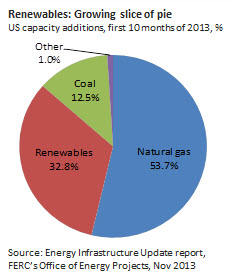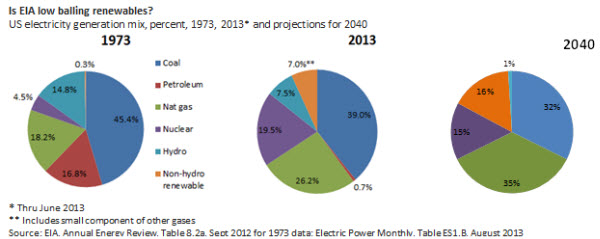The disparity between recent trends and future projections is puzzling.
This is a sample article from the February 2014 issue of EEnergy Informer.
that is the question many independent analysts would like to know. The Energy Information Administration (EIA), is an independent entity within the US Department of Energy, specifically set up to collect, analyze and disseminate unbiased, non-partisan information on energy-related topics. So why is it persistently and chronically under-estimating the growth potential of renewables in its long-term projections? It is a puzzle, perhaps explained by outdated models it uses, or — more likely — outdated cost assumptions that are not supported by recent facts or trends.
Recent data from the Energy Infrastructure Update compiled by the Federal Energy Regulatory Commission’s (FERC) Office of Energy Projects indicates that renewables make up a growing percentage of all new generation coming on line in the US in 2013. Renewables accounted for a stunning 100% of all new capacity additions in Nov 2013, 99% in Oct 2013 and nearly 35% for the first 11 months of 2013. Perhaps these figures are unrepresentative of longer-term trends, but by all indications, renewables are likely to grow at a much faster clip than EIA projects.
Renewable sources now account for 15.9% of total installed US generating capacity, surpassing nuclear and oil combined, which are 9.2% and 4.05%, respectively.

Critics of EIA’s projections are crying foul. “FERC’s latest renewable energy capacity data, coupled with the actual electrical generation from renewable sources, reveal a growing disconnect with the longer-term projections being issued by EIA,” according to Ken Bossong, Executive Director of the SUN DAY Campaign, a pro-renewable advocacy group. “With virtually all new electrical generation coming from renewables during the last two months (Oct & Nov 2013), it is obvious that solar, wind, biomass, geothermal, and hydropower are rapidly outpacing EIA’s unduly conservative forecasts.”
Mr. Bossong, like many others, is troubled by the apparent inconsistencies between recent FERC data — reporting record new renewable installations — and EIA’s projections — which appear increasingly disconnected from the recent trends and indicators. He notes that, “ … the Annual Energy Outlook 2014 (released in mid-Dec 2013)… projected that renewable sources would provide only a paltry 16% of the nation’s electricity supply by 2040. EIA’s own data reveal that renewables were already providing 14.2% of the nation’s electrical generation as of June 30, 2013.” That would mean a measly 2% growth in renewable share between 2013 and 2040, a 27 year period.

He has a point. Someone is obviously not telling the truth — certainly not the whole truth.

